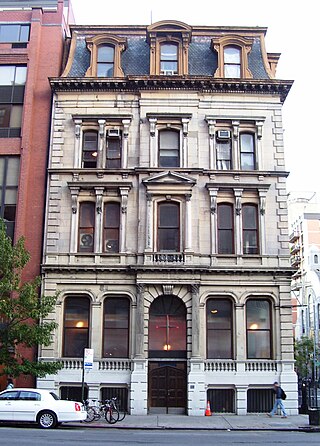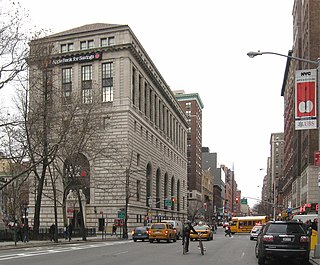Related Research Articles
Six Sigma (6σ) is a set of techniques and tools for process improvement. It was introduced by American engineer Bill Smith while working at Motorola in 1986.

A savings bank is a financial institution whose primary purpose is accepting savings deposits and paying interest on those deposits.

The savings and loan crisis of the 1980s and 1990s was the failure of 32% of savings and loan associations (S&Ls) in the United States from 1986 to 1995. An S&L or "thrift" is a financial institution that accepts savings deposits and makes mortgage, car and other personal loans to individual members.

A mutual savings bank is a financial institution chartered by a central or regional government, without capital stock, owned by its members who subscribe to a common fund. From this fund, claims, loans, etc., are paid. Profits after deductions are shared among the members. The institution is intended to provide a safe place for individual members to save and to invest those savings in mortgages, loans, stocks, bonds and other securities and to share in any profits or losses that result.
H.F. Ahmanson & Co. was a California holding company named after Howard F. Ahmanson Sr. It was best known as the parent of Home Savings of America, once one of the largest savings and loan associations in the United States.

The Financial Institutions Reform, Recovery, and Enforcement Act of 1989 (FIRREA), is a United States federal law enacted in the wake of the savings and loan crisis of the 1980s.

The Lincoln Savings and Loan Association of Irvine, California, was the financial institution at the heart of the Keating Five scandal during the 1980s savings and loan crisis.
Hudson City Bancorp, Inc., based in Paramus, in the U.S. state of New Jersey, was a bank-holding company for Hudson City Savings Bank, its only subsidiary, then the largest savings bank in New Jersey and one of the oldest banks in the United States, with US$50 billion in assets. It is now a fully publicly held entity and a member S&P 500 stock market Index. In 2005, its US$3.93 billion secondary offering of common stock was the largest in United States banking history. At the time, it was also the seventh largest domestic public offering in United States history The bank avoided the excesses of the housing boom and was labeled "best bank of 2007" by Forbes. M&T Bank agreed to acquire Hudson City on August 27, 2012.
In process improvement efforts, quality costs or cost of quality is a means to quantify the total cost of quality-related efforts and deficiencies. It was first described by Armand V. Feigenbaum in a 1956 Harvard Business Review article.

The Greenwich Savings Bank was an American savings bank based in New York City that operated from 1833 to 1981. At the time of its closure in 1981, it was the 16th largest bank in the U.S. by total deposits.

The Metropolitan Savings Bank Building opened on May 30, 1867, at the northeast corner of Third Avenue and East 7th Street, in Manhattan, New York City. Its original address was 10 Cooper Institute. The building, which was designed by architect Carl Pfeiffer in Second Empire style, is four stories high, 45 feet (14 m) wide and 75 feet (23 m) deep, and was considered at the time it opened to be one of the most finely constructed edifices, "from garret to basement." Its facades were composed of white marble, with the upper floor being enclosed by a mansard roof. The building was fireproof, as no combustible materials were used during construction, either internally or externally. The entire cost of the structure was $150,000.

Rochester Savings Bank is a historic bank building located at Rochester in Monroe County, New York. It is a four-story, V-shaped structure, sheathed in Kato stone from Minnesota. It was designed by McKim, Mead and White and built in 1927 to house the Rochester Savings Bank. The building's banking room interior features murals painted by noted artist Ezra Winter.
An accountable care organization (ACO) is a healthcare organization that ties provider reimbursements to quality metrics and reductions in the cost of care. ACOs in the United States are formed from a group of coordinated health-care practitioners. They use alternative payment models, normally, capitation. The organization is accountable to patients and third-party payers for the quality, appropriateness and efficiency of the health care provided. According to the Centers for Medicare and Medicaid Services, an ACO is "an organization of health care practitioners that agrees to be accountable for the quality, cost, and overall care of Medicare beneficiaries who are enrolled in the traditional fee-for-service program who are assigned to it".

The Brooklyn Tower is a supertall mixed-use, primarily residential skyscraper in the Downtown Brooklyn neighborhood of New York City. Developed by JDS Development Group, it is situated on the north side of DeKalb Avenue near Flatbush Avenue. The main portion of the skyscraper is a 74-story, 1,066-foot (325 m) residential structure designed by SHoP Architects and built from 2018 to 2022. Preserved at the skyscraper's base is the Dime Savings Bank Building, designed by Mowbray and Uffinger, which dates to the 1900s.

291 Broadway, also known as the East River Savings Bank Building, is a 19-story high-rise building located at 291 Broadway and Reade Street in the TriBeCa neighborhood of Lower Manhattan, New York City. Designed by the architecture firm Clinton and Russell, the building originally housed the former East River Savings Bank. It served as the YMCA national headquarters from 1949 to 1980, and also housed the YMCA Historical Library during this time. The YMCA sold the building in 1980 when it decided to move the YMCA National Council to Chicago.

The Daryl Roth Theatre is an off-Broadway performance space at 101 East 15th Street, at the northeast corner of the intersection with Union Square East, near Union Square in Manhattan, New York City. The theater, which opened in 1998, is housed in the four-story Union Square Savings Bank building, which was designed by Henry Bacon and built between 1905 and 1907.

The Greenwich Savings Bank Building, also known as the Haier Building and 1356 Broadway, is an office building at 1352–1362 Broadway in the Midtown Manhattan neighborhood of New York City. Constructed as the headquarters of the Greenwich Savings Bank from 1922 to 1924, it occupies a trapezoidal parcel bounded by 36th Street to the south, Sixth Avenue to the east, and Broadway to the west. The Greenwich Savings Bank Building was designed in the Classical Revival style by York and Sawyer.

The Williamsburgh Savings Bank Building, also known as the Weylin and 175 Broadway, is a former bank building at 175 Broadway in the Williamsburg neighborhood of Brooklyn in New York City. Constructed as the headquarters of the Williamsburgh Savings Bank in 1875 and subsequently expanded several times, it occupies the northwest corner of Broadway and Driggs Avenue, just south of the Williamsburg Bridge. The Williamsburgh Savings Bank Building was designed in the Classical Revival style by George B. Post, with interiors by Peter B. Wight.

The Bowery Savings Bank Building, also known as 130 Bowery, is an event venue and former bank building in the Little Italy and Chinatown neighborhoods of Lower Manhattan in New York City. Constructed for the defunct Bowery Savings Bank from 1893 to 1895, it occupies an L-shaped site bounded by Bowery to the east, Grand Street to the south, and Elizabeth Street to the west. The Bowery Savings Bank Building was designed by Stanford White of McKim, Mead & White. Since 2002, it has hosted an event venue called Capitale. The building's facade and interior are New York City designated landmarks, and the building is listed on the National Register of Historic Places.

The Apple Bank Building, also known as the Central Savings Bank Building and 2100 Broadway, is a bank and residential building at 2100–2114 Broadway on the Upper West Side of Manhattan in New York City, New York, United States. Constructed as a branch of the Central Savings Bank from 1926 to 1928, it occupies a trapezoidal city block bounded by 73rd Street to the south, Amsterdam Avenue to the east, 74th Street to the north, and Broadway to the west. The Apple Bank Building was designed by York and Sawyer in the Renaissance Revival and palazzo styles, patterned after an Italian Renaissance-style palazzo.
References
- ↑ Juran, Joseph M. (1962). Quality Control Handbook (2 ed.). New York, New York: McGraw-Hill. pp. 1–34. OCLC 64292499.